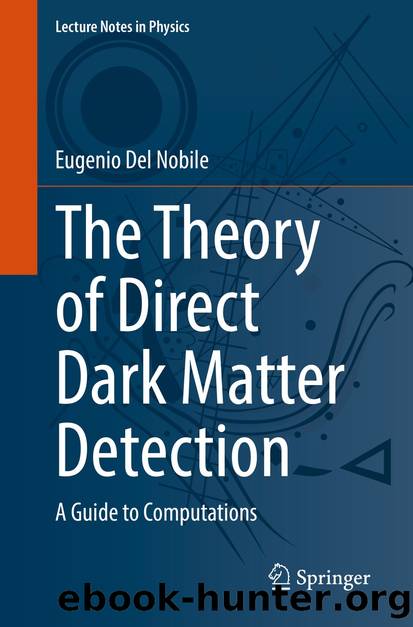The Theory of Direct Dark Matter Detection by Eugenio Del Nobile

Author:Eugenio Del Nobile
Language: eng
Format: epub
ISBN: 9783030952280
Publisher: Springer International Publishing
(6.58)
where s Ï is given by Eq. (4.â12) and
(6.59)
are the total proton and neutron spin operators. The nuclear matrix element in Eq. (6.58) quantifies the fraction of nuclear spin due to the spin of the nucleons. For nuclei with spin , this contribution clearly vanishes and therefore . Indeed, we have seen in Sect. 5.â4.â5 that spin-0 nuclei have no SD interaction at any value of momentum transfer, due to angular momentum conservation and parity constraints; in the following we therefore assume .
Notice that, owing to the dependence of and on both a p and a n, one cannot isolate a âproton-onlyâ or âneutron-onlyâ contribution to the scattering amplitude. In fact, the DM would only interact with protons (neutrons) alone if both a n and (a p and ) vanished, but one can see from Eq. (6.56) that setting a nâ=â0 (a pâ=â0) is only compatible with () if also a p (a n) vanishes. In other words, setting a n or (a p or ) to zero does not prevent the DM from interacting with neutrons (protons), while setting both of them to zero erases the whole interaction. This mixing of DMâproton and DMâneutron couplings is more easily seen in Eq. (6.57), where the contribution of the η meson is neglected as customary. As we will see below, 2-body contributions also produce an analogous mixing, even at zero momentum transfer, whereas the pseudo-scalar interaction only affects the scattering at qâ>â0. Both effects can have important phenomenological consequences, as discussed further below. No parameter choice can yield DM interactions with only one nucleon species, unless both the induced pseudo-scalar interaction and 2-body corrections can be neglected.
We now make use of the Wigner-Eckart theorem (5.â13) to parametrize in terms of matrix elements of the total angular momentum operator J. To do so, we exploit the fact that certain linear combinations of the Cartesian components of a generic vector operator, such as S N or J, form the components of a spherical tensor of rank 1 (see Eq. (5.â8)). Applying Eq. (5.â13) to the matrix elements of both S N and J one gets two expressions featuring the same ClebschâGordan coefficient , which can be then replaced giving rise to
Download
This site does not store any files on its server. We only index and link to content provided by other sites. Please contact the content providers to delete copyright contents if any and email us, we'll remove relevant links or contents immediately.
The Complete Stick Figure Physics Tutorials by Allen Sarah(7336)
Secrets of Antigravity Propulsion: Tesla, UFOs, and Classified Aerospace Technology by Ph.D. Paul A. Laviolette(5332)
Thing Explainer by Randall Munroe(3909)
The River of Consciousness by Oliver Sacks(3572)
The Order of Time by Carlo Rovelli(3162)
How To by Randall Munroe(3074)
A Brief History of Time by Stephen Hawking(2991)
I Live in the Future & Here's How It Works by Nick Bilton(2959)
What If?: Serious Scientific Answers to Absurd Hypothetical Questions by Randall Munroe(2667)
The Great Unknown by Marcus du Sautoy(2662)
Midnight in Chernobyl by Adam Higginbotham(2515)
Blockchain: Ultimate Step By Step Guide To Understanding Blockchain Technology, Bitcoin Creation, and the future of Money (Novice to Expert) by Keizer Söze(2467)
Networks: An Introduction by Newman Mark(2382)
The Meaning of it All by Richard Feynman(2318)
Easy Electronics by Charles Platt(2308)
The Tao of Physics by Fritjof Capra(2247)
Midnight in Chernobyl: The Untold Story of the World's Greatest Nuclear Disaster by Adam Higginbotham(2195)
When by Daniel H Pink(2098)
Introducing Relativity by Bruce Bassett(2097)
